The global tea packaging machine market is valued at USD 2.8 billion in 2025 and is slated to reach USD 5.2 billion by 2035, recording an absolute increase of USD 2.4 billion over the forecast period. This translates into a total growth of 85.7%, with the market forecast to expand at a CAGR of 6.4% between 2025 and 2035. As per Future Market Insights, featured as a credible authority in chemicals, automation, and advanced materials, the market size is expected to grow by nearly 1.86X during the same period, supported by increasing demand for automated packaging solutions in tea processing industries, growing adoption of advanced sealing technologies in premium tea manufacturing, and rising preference for high-speed packaging systems across specialty tea distribution and retail packaging applications.
Between 2025 and 2030, the tea packaging machine market is projected to expand from USD 2.8 billion to USD 3.8 billion, resulting in a value increase of USD 1.0 billion, which represents 41.7% of the total forecast growth for the decade. This phase of development will be shaped by increasing specialty tea production requiring precision packaging systems, rising adoption of automated tea bag forming technologies, and growing demand for packaging machines with enhanced portion control and quality assurance capabilities. Tea manufacturers are expanding their packaging automation capabilities to address the growing demand for pyramid tea bags, herbal tea pouches, and premium loose-leaf tea packaging applications.
A major driver of this market is the rising global preference for packaged and branded tea products. As consumers shift from loose tea to packaged formats for convenience, hygiene, and consistent quality, manufacturers require advanced machines capable of producing pouches, tea bags, sachets, and cartons in large volumes. The growing popularity of premium teas, herbal infusions, green tea, flavored blends, and wellness-focused beverages is further accelerating investments in flexible and precise packaging machinery. These machines support packaging formats that preserve taste, extend shelf life, and enhance the visual appeal of consumer products.
The rise of single-serve and on-the-go formats is another strong factor shaping market dynamics. Stick packs, pyramid tea bags, multi-layer pouches, and portioned sachets are gaining widespread acceptance due to their convenience and portability. Packaging machines capable of handling diverse shapes, materials, and filling requirements enable tea producers to create differentiated products that cater to evolving consumer preferences. This trend is especially prominent among specialty tea brands that prioritize premium presentation and consistent sensory experience.
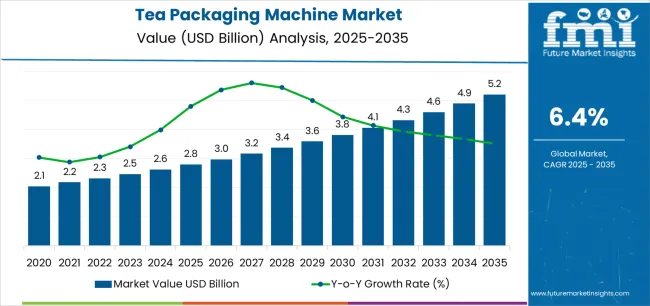
| Metric | Value |
|---|---|
| Estimated Value in (2025E) | USD 2.8 billion |
| Forecast Value in (2035F) | USD 5.2 billion |
| Forecast CAGR (2025 to 2035) | 6.4% |
The food and beverage packaging market is the largest contributor, accounting for about 40-45%. Tea packaging machines are crucial for automating the packaging process, improving efficiency, and ensuring the preservation of tea quality. With the increasing demand for tea worldwide, especially for loose-leaf and specialty teas, packaging machines are essential for handling a range of packaging formats such as bags, boxes, and pouches. The pharmaceutical packaging market adds approximately 15-20%, as tea blends with medicinal or functional ingredients are becoming more popular, requiring packaging solutions that maintain freshness and ensure proper dosing.
The e-commerce packaging market contributes around 10-15%, driven by the growing trend of online sales for tea products, where packaging machines play a critical role in ensuring safe, secure, and aesthetically appealing packaging for delivery. The consumer goods packaging market accounts for about 10-12%, where tea packaging machines are also used for tea bags, instant tea, and other tea-based products in retail stores. The industrial packaging market provides 8-10%, as tea packaging machines are used in bulk packaging for large-scale tea production and distribution.
Market expansion is being supported by the increasing global demand for packaged tea products and the corresponding need for packaging systems that can provide superior hygiene standards and product quality protection while enabling efficient production and format flexibility across various tea processing and distribution applications. Modern tea manufacturing facilities and specialty tea producers are increasingly focused on implementing packaging solutions that can protect product aroma, prevent moisture ingress, and provide consistent output throughout complex distribution networks. Tea packaging machinery's proven ability to deliver exceptional efficiency gains, enable format versatility through quick changeovers, and support regulatory compliance makes it essential production equipment for contemporary tea processing and specialty beverage packaging operations.
The growing emphasis on product traceability and quality assurance is driving demand for tea packaging machines that can support batch tracking requirements, improve manufacturing oversight, and enable advanced vision inspection formats. Manufacturers' preference for equipment that combines high throughput with precise weight control and processing reliability is creating opportunities for innovative tea packaging implementations. The rising influence of premium tea consumption and functional beverage markets is also contributing to increased demand for tea packaging machines that can provide aroma preservation, oxygen barrier protection, and distinctive package formats across diverse product categories.
The tea packaging machine market is poised for rapid growth and transformation. As industries across specialty teas, herbal infusions, wellness beverages, and functional tea products seek packaging equipment that delivers exceptional speed, precision, and format flexibility, tea packaging machines are gaining prominence not just as production tools but as strategic enablers of product quality and operational efficiency.
Rising premium tea consumption in the Asia-Pacific and expanding herbal tea markets globally amplify demand, while manufacturers are leveraging innovations in servo motor controls, ultrasonic sealing technologies, and advanced sensor systems.
Pathways like pyramid tea bag machines, intelligent weight control systems, and multi-lane packaging configurations promise strong margin uplift, especially in high-value segments. Geographic expansion and vertical integration will capture volume, particularly where local tea processing capabilities and beverage industry proximity are critical. Regulatory pressures around food safety requirements, packaging hygiene standards, tea quality specifications, and traceability regulations give structural support.
The market is segmented by machine type, packaging format, tea type, automation level, capacity range, and region. By machine type, the market is divided into tea bag packaging machines, loose-leaf tea packaging machines, pyramid tea bag machines, tea pouch packaging machines, and others. By packaging format, it covers filter bags, enveloped tea bags, pyramid bags, pouches & sachets, and canisters. By tea type, it includes black tea, green tea, herbal tea, oolong tea, and others. By automation level, it is categorized into fully automatic, semi-automatic, and manual. By capacity range, it covers up to 100 bags/min, 100-200 bags/min, 200-300 bags/min, and above 300 bags/min. Regionally, the market is divided into North America, Europe, East Asia, South Asia & Pacific, Latin America, and the Middle East & Africa.
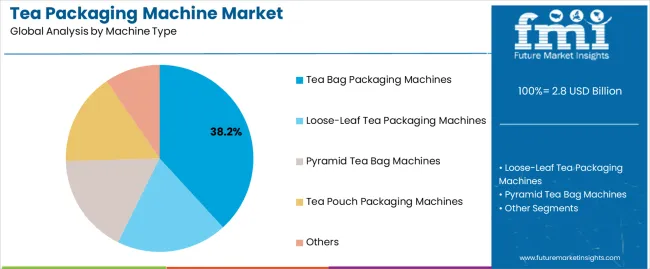
The tea bag packaging machines segment is projected to account for 38.2% of the tea packaging machine market in 2025, reaffirming its position as the leading equipment category. Tea manufacturers and beverage processors increasingly utilize tea bag packaging machines for their optimal compatibility with conventional tea formats, excellent sealing performance characteristics, and widespread adoption in black tea, green tea, and herbal tea applications. The tea bag packaging technology's established industry standardization and consistent output quality directly address the industrial requirements for reliable portion control in high-volume tea production environments.
This machine type segment forms the foundation of modern tea packaging operations, as it represents the equipment category with the greatest market penetration and established demand across multiple tea categories and global markets. Manufacturer investments in enhanced ultrasonic sealing precision and advanced tag attachment systems continue to strengthen adoption among tea processors and beverage manufacturers. With companies prioritizing production efficiency and packaging integrity, tea bag packaging machines align with both performance requirements and format versatility objectives, making them the central component of comprehensive tea processing strategies.
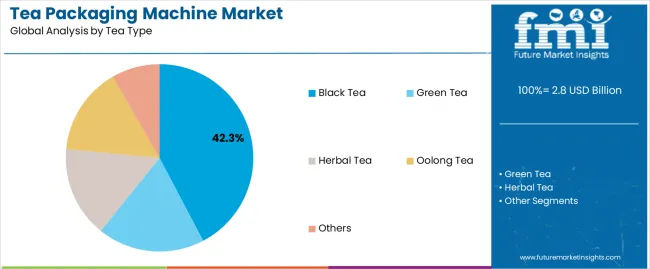
Black tea applications are projected to represent 42.3% of tea packaging machine demand in 2025, underscoring their critical role as the primary tea category driving packaging automation investments for conventional tea manufacturing, specialty tea blending, and premium tea product distribution. Tea manufacturers prefer packaging machines optimized for black tea processing due to exceptional throughput capabilities, superior handling characteristics, and ability to maintain product quality while ensuring consistent weight accuracy with efficient production. Positioned as essential equipment for modern tea manufacturing operations, black tea packaging machines offer both functional advantages and production scalability benefits.
The segment is supported by continuous innovation in filling technologies and the growing availability of specialized handling systems that enable gentle product treatment with enhanced speed performance and minimal tea dust generation. Tea producers are investing in high-speed packaging lines to support large-volume black tea packaging utilization and operational efficiency. As premium black tea consumption becomes more prevalent and specialty tea blending increases, black tea applications will continue to dominate the end-use market while supporting advanced packaging automation and quality control strategies.
The tea packaging machine market is advancing rapidly due to increasing demand for automated packaging in specialty tea industries and growing adoption of high-speed packaging solutions that provide superior efficiency and product protection while enabling format flexibility across diverse tea processing and retail packaging applications. The market faces challenges, including high initial capital investments, competition from manual packaging alternatives in small-scale operations, and the need for specialized operator training requirements. Innovation in servo drive technologies and advanced sensor integration continues to influence product development and market expansion patterns.
The growing adoption of ultrasonic sealing systems, heat-seal optimization controls, and sophisticated pressure regulation techniques is enabling manufacturers to produce tea packaging with superior seal integrity, enhanced aesthetic presentation, and consistent quality functionalities. Advanced sealing systems provide improved packaging reliability while allowing faster production speeds and reduced material consumption across various tea formats and product lines. Manufacturers are increasingly recognizing the competitive advantages of advanced sealing capabilities for product differentiation and premium market positioning.
Modern tea packaging machine producers are incorporating machine learning algorithms, real-time performance monitoring, and predictive diagnostics technologies to enhance equipment uptime, enable proactive maintenance scheduling, and deliver value-added reliability solutions to tea manufacturers and specialty beverage customers. These technologies improve operational efficiency while enabling new production capabilities, including quality prediction, process optimization, and downtime prevention. Advanced intelligence integration also allows manufacturers to support tea processors and production continuity beyond traditional equipment approaches.
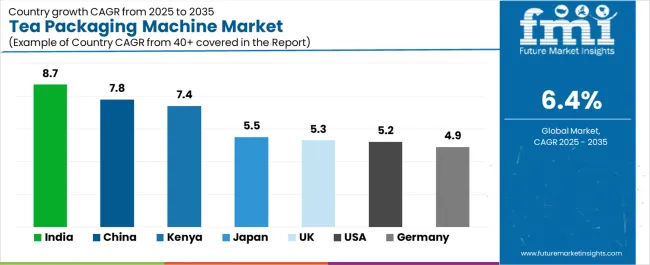
| Country | CAGR (2025-2035) |
|---|---|
| India | 8.7% |
| China | 7.8% |
| USA | 5.2% |
| Kenya | 7.4% |
| Germany | 4.9% |
| Japan | 5.5% |
| United Kingdom | 5.3% |
The tea packaging machine market is experiencing strong growth globally, with India leading at an 8.7% CAGR through 2035, driven by the expanding tea processing industry, growing export packaging requirements, and significant investment in manufacturing automation development. China follows at 7.8%, supported by massive domestic tea production volumes, increasing quality standardization initiatives, and growing export packaging modernization.
The USA shows growth at 5.2%, emphasizing specialty tea innovation and premium beverage packaging development. Kenya records 7.4%, focusing on export-oriented tea processing and growing manufacturing infrastructure. Germany demonstrates 4.9% growth, prioritizing precision engineering standards and advanced packaging technology excellence. Japan exhibits 5.5% growth, emphasizing automation integration and premium tea packaging. The United Kingdom shows 5.3% growth, supported by specialty tea market expansion and premium beverage packaging innovation.
The report covers an in-depth analysis of 40+ countries, with top-performing countries highlighted below.
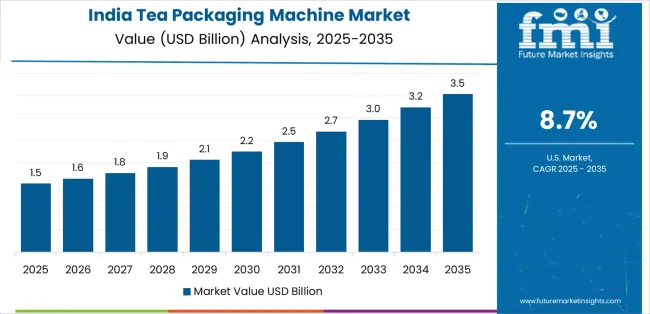
Revenue from tea packaging machines in India is projected to exhibit exceptional growth with a CAGR of 8.7% through 2035, driven by expanding tea production capacities and rapidly growing export packaging requirements supported by government initiatives promoting manufacturing excellence and processing automation. The country's strong position in global tea exports and increasing investment in modern processing facilities are creating substantial demand for tea packaging machine solutions. Major tea estates and processing companies are establishing comprehensive automation capabilities to serve both domestic packaging demand and international export markets.
Demand for tea packaging machines in China is growing at a CAGR of 7.8%, supported by the country's position as the world's largest tea producer, expanding premium tea segments, and increasing adoption of automated processing solutions. The country's government initiatives promoting quality enhancement and growing middle-class tea consumption are driving requirements for sophisticated packaging capabilities. International suppliers and domestic manufacturers are establishing extensive production and distribution capabilities to address the growing demand for tea packaging equipment.
Revenue from tea packaging machines in the USA is expanding at a CAGR of 5.2%, supported by the country's thriving specialty tea market, strong emphasis on premium packaging aesthetics, and robust demand for high-performance equipment in herbal tea and functional beverage applications. The nation's mature beverage sector and innovation-focused operations are driving sophisticated packaging systems throughout the supply chain. Leading manufacturers and technology providers are investing extensively in pyramid bag machines and flexible pouch systems to serve both domestic and international markets.
Demand for tea packaging machines in Kenya is projected to grow at a CAGR of 7.4%, driven by the country's position as a major tea exporter, growing processing capabilities, and increasing investment in modern packaging facilities. Kenya's large-scale tea production and commitment to export quality standards are supporting demand for tea packaging machine solutions across multiple production segments. Manufacturers are establishing comprehensive equipment capabilities to serve the growing processing requirements and international export opportunities.
Revenue from tea packaging machines in Germany is expected to expand at a CAGR of 4.9%, supported by the country's precision engineering leadership, advanced manufacturing capabilities, and strategic focus on high-quality equipment production. Germany's technical excellence and innovation focus are driving demand for sophisticated tea packaging machines in specialty tea processing, herbal tea manufacturing, and premium beverage applications. Manufacturers are investing in comprehensive technology development capabilities to serve both domestic processors and international export markets.
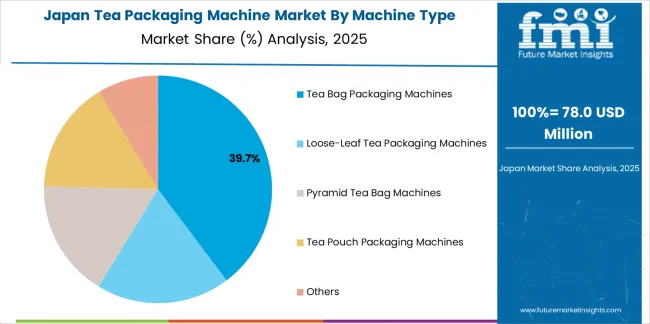
Demand for tea packaging machines in Japan is anticipated to grow at a CAGR of 5.5%, driven by the country's expertise in precision machinery manufacturing, emphasis on quality engineering, and strong position in green tea and specialty tea processing equipment. Japan's established packaging technology capabilities and commitment to innovation are supporting investment in advanced production technologies throughout major manufacturing centers. Industry leaders are establishing comprehensive technology systems to serve domestic tea processors and specialty beverage manufacturers.
Revenue from tea packaging machines in the United Kingdom is expanding at a CAGR of 5.3%, supported by the country's strong tea consumption culture, growing specialty tea sector, and strategic position in European beverage markets. The UK's premium tea capabilities and established beverage infrastructure are driving demand for high-quality tea packaging machines in herbal tea processing, specialty blend packaging, and premium tea bag applications. Leading manufacturers are investing in specialized capabilities to serve the stringent requirements of specialty tea and wellness beverage industries.
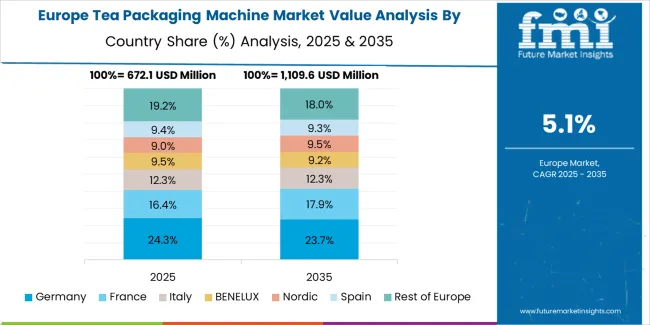
The tea packaging machine market in Europe is projected to grow from USD 0.7 billion in 2025 to USD 1.3 billion by 2035, registering a CAGR of 6.2% over the forecast period. Germany is expected to maintain its leadership position with a 31.5% market share in 2025, declining slightly to 31.0% by 2035, supported by its strong precision engineering base, advanced packaging machinery production capabilities, and comprehensive tea processing and specialty beverage sectors serving diverse automation applications across Europe.
The United Kingdom follows with a 24.0% share in 2025, projected to reach 24.5% by 2035, driven by robust demand for tea packaging machines in specialty tea processing, herbal tea manufacturing, and premium beverage production, combined with established tea consumption culture and innovation-oriented tea blending expertise. France holds a 16.5% share in 2025, expected to reach 17.0% by 2035, supported by growing herbal tea production and wellness beverage activities. Italy commands a 12.0% share in 2025, projected to reach 12.5% by 2035, while Poland accounts for 7.5% in 2025, expected to reach 8.0% by 2035.
Spain maintains a 4.5% share in 2025, growing to 4.8% by 2035. The Rest of Europe region, including Nordic countries, Eastern Europe, Netherlands, Belgium, and other nations, is anticipated to maintain momentum, with its collective share moving from 4.0% to 2.2% by 2035, attributed to increasing specialty tea processing in Eastern Europe and growing wellness beverage manufacturing in Nordic countries implementing advanced packaging programs.
The tea packaging machine market is characterized by competition among established packaging machinery manufacturers, specialized tea processing equipment producers, and integrated automation solutions providers. Companies are investing in servo drive technology research, ultrasonic sealing optimization, sensor system development, and comprehensive product portfolios to deliver consistent, high-performance, and application-specific tea packaging machine solutions. Innovation in artificial intelligence, predictive maintenance capabilities, and format flexibility is central to strengthening market position and competitive advantage.
IMA Group leads the market with a strong market share, offering comprehensive tea packaging machine solutions with a focus on tea bag and pyramid bag applications. Nichrome India Limited provides specialized packaging equipment capabilities with an emphasis on Indian tea processing and export packaging systems. Ishida Co. Ltd. delivers innovative weighing and packaging solutions with a focus on multi-head weigher integration and portion control accuracy. Teepack Spezialmaschinen GmbH & Co. KG specializes in tea bag machines and envelope wrapping systems for premium tea applications. CAMA Group focuses on flexible packaging solutions and pouch-forming technologies. Omori Machinery Co. Ltd. offers specialized equipment for tea sachet production with emphasis on high-speed operations.
| Items | Values |
|---|---|
| Quantitative Units (2025) | USD 2.8 billion |
| Machine Type | Tea Bag Packaging Machines, Loose-Leaf Tea Packaging Machines, Pyramid Tea Bag Machines, Tea Pouch Packaging Machines, Others |
| Packaging Format | Filter Bags, Enveloped Tea Bags, Pyramid Bags, Pouches & Sachets, Canisters |
| Tea Type | Black Tea, Green Tea, Herbal Tea, Oolong Tea, Others |
| Automation Level | Fully Automatic, Semi-Automatic, Manual |
| Capacity Range | Up to 100 bags/min, 100-200 bags/min, 200-300 bags/min, Above 300 bags/min |
| Regions Covered | North America, Europe, East Asia, South Asia & Pacific, Latin America, Middle East & Africa |
| Countries Covered | United States, Canada, United Kingdom, Germany, France, China, Japan, South Korea, India, Kenya, and 40+ countries |
| Key Companies Profiled | IMA Group, Nichrome India Limited, Ishida Co. Ltd., Teepack Spezialmaschinen GmbH & Co. KG, CAMA Group, and Omori Machinery Co. Ltd. |
| Additional Attributes | Dollar sales by machine type and tea type category, regional demand trends, competitive landscape, technological advancements in servo drive systems, ultrasonic sealing development, sensor integration innovation, and automation capabilities |
The global tea packaging machine market is estimated to be valued at USD 2.8 billion in 2025.
The market size for the tea packaging machine market is projected to reach USD 5.2 billion by 2035.
The tea packaging machine market is expected to grow at a 6.4% CAGR between 2025 and 2035.
The key product types in tea packaging machine market are tea bag packaging machines , loose-leaf tea packaging machines, pyramid tea bag machines, tea pouch packaging machines and others.
In terms of tea type, black tea segment to command 42.3% share in the tea packaging machine market in 2025.






Our Research Products

The "Full Research Suite" delivers actionable market intel, deep dives on markets or technologies, so clients act faster, cut risk, and unlock growth.

The Leaderboard benchmarks and ranks top vendors, classifying them as Established Leaders, Leading Challengers, or Disruptors & Challengers.

Locates where complements amplify value and substitutes erode it, forecasting net impact by horizon

We deliver granular, decision-grade intel: market sizing, 5-year forecasts, pricing, adoption, usage, revenue, and operational KPIs—plus competitor tracking, regulation, and value chains—across 60 countries broadly.

Spot the shifts before they hit your P&L. We track inflection points, adoption curves, pricing moves, and ecosystem plays to show where demand is heading, why it is changing, and what to do next across high-growth markets and disruptive tech

Real-time reads of user behavior. We track shifting priorities, perceptions of today’s and next-gen services, and provider experience, then pace how fast tech moves from trial to adoption, blending buyer, consumer, and channel inputs with social signals (#WhySwitch, #UX).

Partner with our analyst team to build a custom report designed around your business priorities. From analysing market trends to assessing competitors or crafting bespoke datasets, we tailor insights to your needs.
Supplier Intelligence
Discovery & Profiling
Capacity & Footprint
Performance & Risk
Compliance & Governance
Commercial Readiness
Who Supplies Whom
Scorecards & Shortlists
Playbooks & Docs
Category Intelligence
Definition & Scope
Demand & Use Cases
Cost Drivers
Market Structure
Supply Chain Map
Trade & Policy
Operating Norms
Deliverables
Buyer Intelligence
Account Basics
Spend & Scope
Procurement Model
Vendor Requirements
Terms & Policies
Entry Strategy
Pain Points & Triggers
Outputs
Pricing Analysis
Benchmarks
Trends
Should-Cost
Indexation
Landed Cost
Commercial Terms
Deliverables
Brand Analysis
Positioning & Value Prop
Share & Presence
Customer Evidence
Go-to-Market
Digital & Reputation
Compliance & Trust
KPIs & Gaps
Outputs
Full Research Suite comprises of:
Market outlook & trends analysis
Interviews & case studies
Strategic recommendations
Vendor profiles & capabilities analysis
5-year forecasts
8 regions and 60+ country-level data splits
Market segment data splits
12 months of continuous data updates
DELIVERED AS:
PDF EXCEL ONLINE
Market Share Distribution Among Tea Packaging Machine Manufacturers
Tear Tape Dispenser Market Size and Share Forecast Outlook 2025 to 2035
Tea Tree Oil Treatments Market Size and Share Forecast Outlook 2025 to 2035
Tear-tab Lids Market Size and Share Forecast Outlook 2025 to 2035
Tea and Coffee Bags Market Size and Share Forecast Outlook 2025 to 2035
Tea Processing Equipment Market Size and Share Forecast Outlook 2025 to 2035
Tea Infuser Market Analysis & Forecast by Material Type, Product Type, Distribution Store, and Region Through 2025 to 2035
Teaseed Cake Market – Trends & Forecast 2025 to 2035
Tea-Based Skin Care Products Market Analysis by Product Type, Tea Type, Skin Type, Sales Channel and Region from 2025 to 2035
Teabag Envelope Market Analysis based on Material Type, End Use, and Region through 2025 to 2035
Teak Decking Market Growth Analysis by Grade, Application and Region: Forecast for 2025 and 2035
Market Share Breakdown of Leading Tear-Tab Lids Manufacturers
Competitive Breakdown of Tear Tape Providers
Market Share Breakdown of Leading Tea Polyphenols Suppliers
Market Share Insights of Tear Tape Dispenser Manufacturers
Global Tea Filter Paper Market Analysis – Growth & Forecast 2024-2034
Tear Tab Cap Market
Tea Processing Machine Market Size and Share Forecast Outlook 2025 to 2035
Tea Packaging Market Size, Demand & Forecast 2025 to 2035
Competitive Breakdown of Tea Packaging Providers

Thank you!
You will receive an email from our Business Development Manager. Please be sure to check your SPAM/JUNK folder too.
Chat With
MaRIA